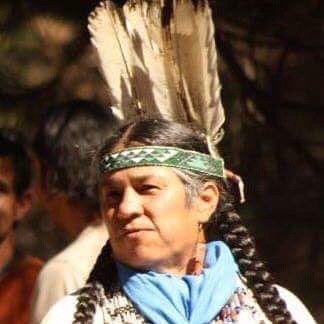「原住民の女性達ーその精神的権利と責任」

女性の地位向上委員会の 63 回目のセッションに於いて、それに並行して USHRN は「原住民の女性達ーその精神的権利と責任」と題した講演を共催した。
講演は USHRN の代表 Dr. Rosalee Gonzalez のもと、北カリフォルニア、ネイティブア メリカン Wintu 族の酋長 Caleen Sisk そして MKEA のプログラムコーディネーテターで あるネイティブハワイアンのリーダー(チャンターでもありダンサー) Pua Case の 2 人を 迎え、和やかな雰囲気で行われた。
2人はネイティブハワイアンの神聖な地であるマウナ ケアに、地上 14 階、地下 2 階建ての天文台が建設されようとしている事から紐 解いて、人権侵害の問題を提起した。
建設されようとしている施設は、現在ハワイ島に立つどの建物よりも高くなる予定。
さ らにその文化的背景、そしてそこに広がる何百とあるハワイ島の啓もう的な場所、聖地を 荒廃させることになる。
建設プロジェクトは、カナダ、中国、インドそして日本の海外企 業共同開発のもと、政府間の出資で進めようとしていて、その 4 ヶ国そしてカリフォルニ ア大学、カリフォルニア工科大学の協力もあり、30 メートルの巨大国際的観測所になる。
ネイティブハワイアンは、これまでも常に自分達の山々と親しく結びつき、山々に対し て深い宗敬の念を抱いてきた。
ネイティブハワイアン、カナカマオリはまた、彼らの神聖 な山、マウナケアをワケア(空の父である山)として信仰を厚くしている。
マウナケアは、 カナカマオリにとって文化的に重要な山であり、彼らの祖先と精神的に繋がる神聖な地で ある。
50 年以上に渡る天文学の発展、開発によりマウナケアは、既に立てられている 22 台も の天文台の存在によってでさえ、実際に重大な不利益な問題を負ってきた。
加えて TMT(30 メートルの巨大望遠鏡)の建設は悪影響を及ぼし、カナカマオリの文化そして宗教的慣習 に干渉するものである。
これはまさに UNDRIP 先住民の権利に関する国際連合宣言 12 条 1 及び 25 にある精神的慣習の基準に違反している上、32 条 2 にある自主的な事前の十分な 説明による同意に基づくものではない。
ましてや TMT は保護区に指定されているマウナケ アの地域への建設ということで、ハワイ州法 HAR13-5-30 の基準を満たしていない。これ もまた UNDRIP の 29 条 1 に違反している。
州法では環境保全、環境保護が焦点となって いる。
UNDRIP では条例 11 条と 12 条にあるように、明確に、ハワイ州を含むアメリカ合衆国 はネイティブハワイアンの文化と宗教上の慣習を尊ばなければならないとされている。
ハ ワイ州の努力にも関わらず、TMT プロジェクト進めようとしている派を含めた全てのグル ープは人種差別撤廃委員会で総合的推奨 23 とは違った反対の動きを推し進めようとしている。
その中にあって、アメリカの州の委員たちは、ネイティブハワイアンのコミュニテ ィーが彼らの権利を行使し、自らの文化伝統そして慣習をよみがえらせる事が出来るかど うかを視察しに訪れる必要がある。マウナケアにおける TMT 建設は、直接の国際法違反であり、 ネイティブの人々の保護宣言に対するのと同様に、カナカマオリへの不当な行為である。
Translation : Lahui Japan Chisato Torikai
During the sixty-third session of the Commission on the Status of Women, the USHRN co-sponsored a side-event entitled “Indigenous Women: Spiritual Rights and Responsibilities. The event was moderated by USHRN Executive Director Dr. Rosalee Gonzalez. Two of the program's speakers, Chief Caleen Sisk of the Winnemem Wintu tribe of Northern California, and Pua Case, Program Coordinator for Mauna Kea Education and Awareness of Hawaiʻi, presented on the human rights violations connected to the proposed construction of a 18-story observatory on Mauna Kea, a mountain sacred to indigenous Hawaiians.
The proposed observatory would be taller than any existing building on Hawai‘i Island and would further devastate the cultural landscape and open space of the northern plateau that includes hundreds of Hawaiian cultural sites and shrines. The project is led by corporate and foreign interests of the Thirty Meter Telescope International Observatory LLC including the University of California, California Institute of Technology, and the nations of Canada, China, India, and Japan.
Indigenous peoples have always been connected to and have held reverence for their mountains. Kanaka Maoli, indigenous Hawaiians, hold great reverence for their holy mountain, Mauna Kea, also known as Mauna a Wākea (Mountain of Sky Father). Mauna Kea is a place of cultural significance for Kanaka Maoli, a place of spiritual connection with one’s ancestors, a sacred temple.
Over 50 years of astronomy development has inflicted substantial, significant, and adverse impacts upon Mauna Kea with the present 22 structures built by multinational corporations. The project, dubbed “TMT” (Thirty Meter Telescope), would also negatively impact and interfere with the cultural and religious practices of Kanaka Maoli. This is a violation of the standards set by the UN Declaration on the Rights of Indigenous Peoples (UNDRIP), such as articles 12 (1) and 25 regarding spiritual practices, and article 32 (2) on free, prior, and informed consent. Furthermore, TMT does not meet the requirements of Hawai’i state law HAR 13-5-30 for construction on lands zoned “conservation,” which Mauna Kea is. This is also a violation of UNDRIP article 29 (1), which focuses on conservation and the protection of the environment.
As articulated in the UNDRIP articles 11 and 12, the United States, including the state of Hawai’i, is obligated to respect the cultural and religious customs of indigenous Hawaiians. The efforts undertaken by the state of Hawai’i and all parties involved in advancing the TMT project, also run contrary to General Recommendation 23 of the Committee on the Elimination of Racial Discrimination, which among others, calls upon State parties (like the US) to ensure that “indigenous communities can exercise their rights to practice and revitalize their cultural traditions and customs…” The construction of TMT on Mauna Kea is in direct violation of these international legal norms and would be an injustice against Kanaka Maoli as well as all indigenous peoples the Declaration aims to protect.
photo : Chief Caleen Sisk of the Winnemem Wintu tribe, Pua Case and her daughter Hawane and Jason Momoa
左から ハヴァネ ロイス、ジャイソン モモア、プア ケース、カリーン シスク